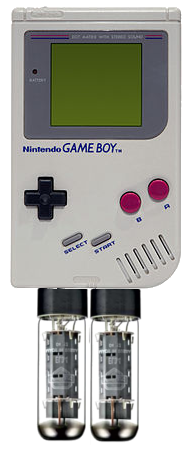1 Aug 13, 2012 3:10 am
Re: Getting good low-end from a DMG (56 replies, posted in Nintendo Handhelds)
2 Aug 12, 2012 8:25 pm
Re: Getting good low-end from a DMG (56 replies, posted in Nintendo Handhelds)
danimal cannon wrote:Lol like 6L6s or EL34s. Tubes were something they used before transistors, and now have found a market in guitar amplifier because of the smooth gain staging they have when overloaded
Word, I have an old music man tube amp, shit's LOUD. I was just wondering how the hell you'd throw them in a DMG hahahaha, guess you meant that they're in the amp, not the gameboy itself. You run your gameboys through tube amps?
That would make more sense. I can't imagine how you'd fit an entire tube into a DMG.... I've put a gameboy through a tube-complimented amp before and it sounds spankin though.
3 Aug 12, 2012 5:25 am
Re: Getting good low-end from a DMG (56 replies, posted in Nintendo Handhelds)
Other things you can do is making your "volume" levels for your WAV instruments seem lower (frostbyte know more about this than do).
Also - you might want to look at adding some sort of tubes for extra warmth or adding some different capacitors.
How would I add tubes to the DMG?? Or do you meant he amp.... I'm very interested.
4 Jun 25, 2012 5:10 am
Re: Sweep, shape, and pulse command mysteries (18 replies, posted in Nintendo Handhelds)
hmmm... well I guess that just ensures that LSDJ will always have some sort of a learning curve to keep me interested. I still know more now than I did at the start of this thread. Thanks!
5 Jun 25, 2012 3:03 am
Re: Sweep, shape, and pulse command mysteries (18 replies, posted in Nintendo Handhelds)
I'm still reading the manual.... the S command is so much more clear now. And I definitely didn't know that it affected the kit instruments differently.
I'm still missing some details though... The manual says "...the first digit affects pitch"... and then later describes (in the "pitch bend" section) that P02 bends up pitch with a speed of 2, and PFE bends down pitch with a speed of 2.
But if I set up a default pulse in PU1, using D4, and the sweep set to FE, it doesn't seem to be bending anywhere. It's just a sustained pulse, no different from FF
6 Jun 25, 2012 2:48 am
Re: Sweep, shape, and pulse command mysteries (18 replies, posted in Nintendo Handhelds)
Thanks! Though in my defense, I read the manual in 2010 and I totally don't remember detailed info on the sweep commands.
Course.... at that time I was probably just looking for the section that answered "HOW DO I MAKE A SWEET CHIPTUNE"?
7 Jun 25, 2012 1:51 am
Topic: Sweep, shape, and pulse command mysteries (18 replies, posted in Nintendo Handhelds)
I've been using LSDJ for quite a while now, and I think I'm just beginning to get a full handle on the interface.
But there are just a few features that I've never really understood... I've just kind of experimented with them until I found something that floats my boat. I've searched the forums periodically and never found the answers I'm really looking for. Same with youtube tuts.
In the pulse instruments, how does the sweep work?? what do each of those two digits do? Maybe one designates the sweep start and the other the speed? When I use the S command in the table (which I assume means sweep) it doesn't seem to sweep at all... it just changes the sound of the noise channel.
...and ON the noise channel....
What are the two hex digits next to the shape parameter?? First digit changes type of sound... the other velocity?
And lastly, the pitch bend command. What are each of those digits doing exactly??
You would all be my heroes.
8 Jun 23, 2012 9:58 am
Re: Art installation using a Gameboy (11 replies, posted in Nintendo Handhelds)
hmm
Spectacle.
9 Jun 14, 2012 1:16 am
Re: How exactly does the noise channel work? (14 replies, posted in Nintendo Handhelds)
I WOULD be interested to know exactly how to use the NOI channel though. Everytime I use it, it just feels like I'm flipping through random hex numbers until I find something that sounds good.
SHAPE: FF
^^
| |
| |
| Envelope?
|
Speed?
10 Jun 13, 2012 6:20 am
Re: Chip For Cancer - Volume I (92 replies, posted in Releases)
11 Jun 13, 2012 6:14 am
Re: Chip For Cancer - Volume I (92 replies, posted in Releases)
AGGH!! Don't close it before I drop dollas!!!
12 Jun 13, 2012 3:34 am
Re: How exactly does the noise channel work? (14 replies, posted in Nintendo Handhelds)
White noise is the sound of all 20,000 frequencies playing all at once.
http://www.howstuffworks.com/question47.htm <------------my source
According to belogic's link, the DMG doesn't work in quite the same way.... but similar. Instead of playing all freqs at once, it plays all possible bits in super-rapid succession.
A pulse uses two bits: on, and off. a wav uses 4 bits, each representing an approximation of an analog sample. Lets say that an E of the 4th octave is 1001 (I'm totally making those digits up for the sake of an ex.).
I guess you could say it uses that same logic that an arp does.
13 Jun 7, 2012 11:52 pm
Re: The Ghost Servant- "These Walls are a Farce" Lyric Video (4 replies, posted in Motion Graphics)
........rage.
14 Jun 5, 2012 10:48 pm
Re: Short Documentary on the NZ chiptune community (18 replies, posted in General Discussion)
Awesome.
..And,
In July I'm leaving to Auckland on study-abroad.
After discovering that there's a sweet chiptune scene,
well, I've pretty much just creamed all over my keyboard.
I'm going to clean this up now.

